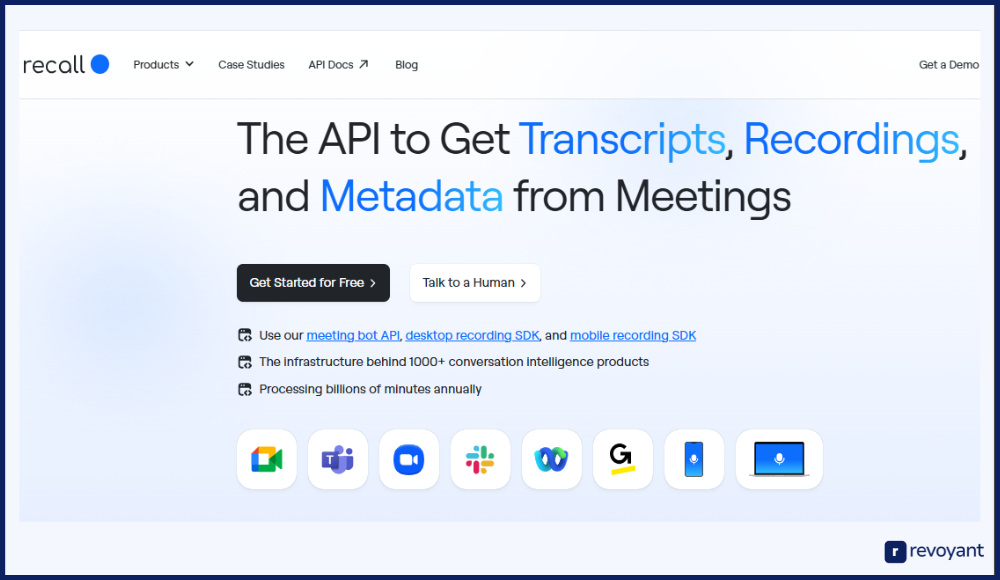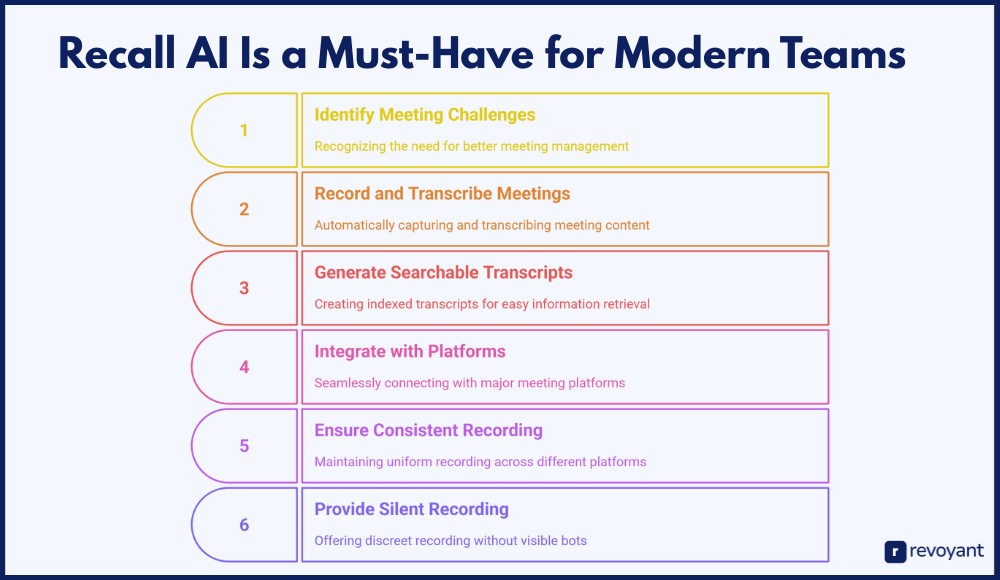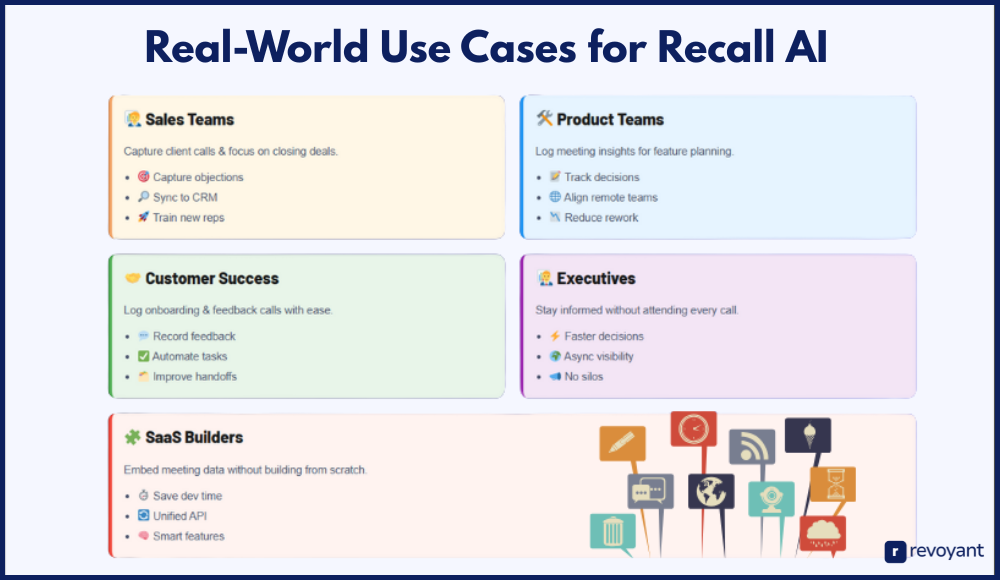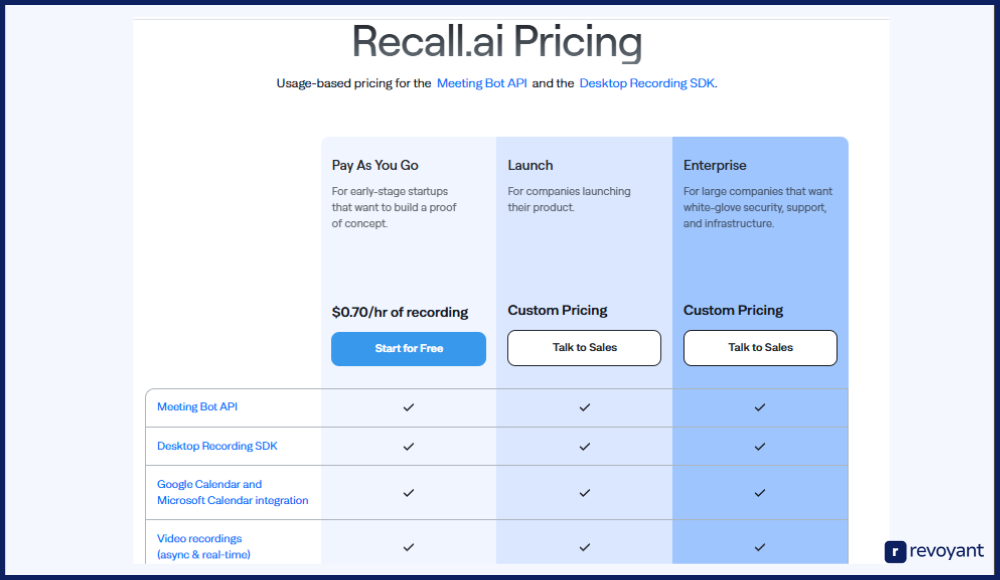⚡ Why This Blog Matters
Important meeting insights often get lost in conversation—but Recall AI captures every moment by automatically recording, transcribing, and organizing your discussions.
🧠 What You’ll Learn Here
Discover how Recall AI records to Zoom, Teams, or browser, transcribes accurately, tags speakers, identifies key highlights, and syncs meeting notes—offering search, share, and export features for transcripts and summaries.
🎯 Who Should Read This
Ideal for professionals, team leads, project managers, and students who want to capture, organize, and leverage meeting content effortlessly.
Staying focused during meetings is tough when you’re also trying to take notes, track action items, and remember who said what. That’s where Recall AI comes in. It’s a background tool that quietly joins your meetings across platforms like Zoom, Google Meet, and Microsoft Teams—recording, transcribing, and summarizing everything without you lifting a finger.
Whether you’re part of a fast-moving sales team, managing remote employees, or running back-to-back calls, Recall AI makes it easy to keep a record of every conversation. No bots joining meetings. No need to hit “record.” Just accurate transcripts and searchable meeting notes that sync with your workflow.
If you’re looking for a way to capture and review meetings without the hassle, this guide will help you understand how Recall AI works, what it offers, and why it could be the right fit for your team.
What You’ll Learn About Recall AI in This Guide
- A clear overview of what Recall AI is and how it works
- Reasons why teams and developers may want to use it
- A breakdown of key features with real-world context
- Practical use cases across sales, product, support, and leadership
- A pros and cons table with visual highlights
- Updated pricing details with plan comparisons
What is Recall AI and How Does It Record Meetings Without Bots?
Recall AI is a meeting infrastructure solution that works quietly in the background, connecting directly to video platforms like Zoom, Google Meet, and Microsoft Teams. It doesn’t rely on visible bots to record your sessions. Instead, it uses native APIs to securely access and transcribe meetings, making it ideal for developers, teams, and platforms that want to automate this process without manual effort.

With Recall AI, you can:
- Record meetings across platforms without bots
- Access real-time or post-call transcripts
- Get speaker-labeled summaries and highlights
- Integrate recordings into your own tools via API
- Save hours of development by skipping complex video integrations
It’s built for teams that want to capture conversations without interrupting them—and for products that need meeting data as part of their workflow.
Why Recall AI Is a Must-Have for Modern Teams and Tools
If your team relies on meetings to move work forward—or if you’re building products that tap into meeting data—Recall AI solves challenges you may not even realize are costing you time, focus, and operational clarity.

Here’s why it stands out:
Struggling to Keep Track of Back-to-Back Meetings?
When your schedule is filled with back-to-back calls, it’s easy to lose track of what was said, what needs follow-up, and who committed to what. Whether it’s sales demos, product reviews, or client onboarding, information often slips through the cracks. With Recall AI, every conversation is recorded and transcribed automatically, turning your meetings into accurate, searchable meeting notes that your team can refer back to for decisions, next steps, and accountability, all without the need to hit record or take notes manually.
For growing teams, this means less time wasted in follow-ups and more time executing with confidence.
Tired of Taking Notes During Every Meeting?
Taking notes while trying to participate actively in a conversation is a mental juggling act. You either miss what’s being said or end up writing down half-formed thoughts. This leads to incomplete records and misalignment after the meeting. Recall AI eliminates this friction entirely.
By generating speaker-labeled transcripts and concise summaries automatically, it allows team members to focus fully on the discussion. They can review the highlights later, share decisions with others, or sync takeaways into project management tools—without losing momentum during the actual call.
Instantly Search Transcripts and Summaries From Any Call
Recording meetings is only helpful if you can find the information when you need it. Digging through hour-long video files or audio recordings is not efficient, especially when you’re under pressure.
Recall AI gives you clean, searchable transcripts where every word is indexed. Want to find when a client mentioned a deadline? Or when your team agreed on a pricing change? Just type in a keyword. Combined with summaries and speaker insights, this AI summarization tool turns meetings into a usable knowledge base instead of letting insights fade away.
Building an App? Add Meeting Intelligence Instantly with Recall AI
If you’re developing a platform—whether it’s focused on sales enablement, coaching, virtual assistance, or customer experience—chances are you need access to meeting data. However, integrating directly with each video conferencing platform is complex, time-consuming, and prone to compliance risks.
Recall AI offers a plug-and-play infrastructure layer that connects to Zoom, Google Meet, and Microsoft Teams via official APIs. This means you can instantly pull in high-quality meeting recordings, transcripts, and metadata—without managing separate connections or building from scratch. It saves months of backend work and lets your product ship faster.
Prefer Privacy? Record Meetings Without Bots Using Recall AI
Meeting participants are increasingly sensitive to bots joining calls. In some cases, it even leads to mistrust or hesitation—especially on external calls. With Recall AI, no one sees a bot joining the meeting because it doesn’t rely on a visible participant to record. Instead, it integrates natively via each platform’s backend.
This makes it ideal for customer-facing teams, sensitive conversations, or product integrations where you want recording to happen invisibly and without disruption. The user experience stays smooth and distraction-free, while the full meeting is still captured securely in the background.
Consistently Record Every Meeting—Zoom, Teams, or Meet
Using multiple meeting platforms across teams, clients, or departments is common—especially in remote-first or hybrid environments. But this creates challenges around consistency. A solution that works for Zoom might fail on Teams. Formats may differ. Data quality may vary.
Recall AI solves this by acting as a unified layer across all major meeting platforms. Whether your team uses Google Meet for internal syncs and Zoom for client calls, Recall captures everything with the same accuracy, format, and delivery method. This creates a reliable system of record and ensures no gaps in your knowledge base, regardless of which platform you’re using that day.
Key Features That Make Recall AI a Game-Changer
Recall AI is more than a meeting transcription tool—it’s a foundational layer that empowers teams and developers to build workflows, platforms, and processes around meetings. Below are the standout features that make it a smart solution for modern organizations:
| 🧩 Feature | 🔎 What It Does | 💡 Why It Matters |
|---|---|---|
| API-Based Recording | Records via platform APIs without visible bots. | Keeps calls private and distraction-free. |
| Cross-Platform Support | Supports Zoom, Meet, and Teams natively. | One system for all your meetings. |
| Speaker-Labeled Transcripts | Identifies who said what during calls. | Helps track decisions and responsibilities. |
| Meeting Summaries | Generates key highlights from each call. | Saves time on rewatching full meetings. |
| Developer API | Offers direct access to recordings and data. | Speeds up custom product development. |
| Security & Compliance | Uses encryption and native permissions. | Keeps sensitive data protected. |
Native API-Based Meeting Recording
Recall AI connects directly to Zoom, Google Meet, and Microsoft Teams using each platform’s official APIs. That means it doesn’t rely on clunky browser bots or visible meeting participants to capture audio and video. Instead, the recording happens in the background, securely and silently.
Why this matters: You get high-quality, reliable recordings every time, without disrupting the meeting experience for participants. This is especially valuable for customer calls or executive meetings where a visible recording bot might feel intrusive or unprofessional.
Cross-Platform Support (Zoom, Teams, Google Meet)
Whether you’re a startup that uses Google Meet or an enterprise that hosts webinars on Zoom and internal syncs on Microsoft Teams, Recall AI handles it all. There’s no need to toggle between tools, build platform-specific workarounds, or manage different transcription pipelines.
Why this matters: It simplifies operations across departments, geographies, and customer support. You can maintain one consistent process for recording and transcription, regardless of which tool is used on the front end.
Automatic Transcripts with Speaker Labels
Every meeting is transcribed with clear speaker attribution, allowing you to follow conversations line by line. Each person’s voice is identified, helping you track who asked questions, made commitments, or raised concerns.
Why this matters: Accurate transcripts aren’t just helpful for documentation—they create accountability. Teams can revisit decisions, understand context, and assign follow-up actions with confidence. It also helps with coaching, onboarding, and client handoffs.
Meeting Summaries for Fast Recall
Long meetings often boil down to a few important outcomes. Recall AI generates a short, structured summary after each call, so you don’t need to scroll through dozens of transcript lines or rewatch the entire recording.
Why this matters: Managers, executives, and cross-functional teams save time by reviewing highlights instead of full meetings. This is especially useful in high-volume environments where multiple meetings happen every day and clarity is key.
Developer-First API Access
Recall AI was designed for builders. If you’re creating tools that depend on meeting intelligence, such as note-taking apps, sales intelligence tools, or internal knowledge platforms, Recall’s API gives you direct access to all meeting data.
Why this matters: Instead of building complex integrations with Zoom, Teams, and Meet individually, you can use Recall AI as a single entry point. This shortens your development cycle, reduces overhead, and lets you bring your product to market faster.
Secure & Scalable Infrastructure
Security is built into every layer of Recall AI. It uses best practices for encryption, platform permissions, and user access. It also respects the data-sharing rules of each video platform it connects to, ensuring compliance with internal policies and external regulations.
Why this matters: Whether you’re handling internal strategy calls, financial planning sessions, or regulated industry meetings, Recall AI gives you the confidence that all data is being managed responsibly and safely.
Real-World Use Cases for Recall AI
Recall AI supports a wide range of teams, roles, and software products, especially those that rely on meetings as a core part of their operations. Below are some practical ways it’s being used today:

Sales Teams: Capture Every Client Call with Confidence
Sales teams use Recall AI to automatically record and transcribe client calls, demos, and negotiations. With speaker-labeled transcripts and call summaries, reps can focus on the conversation instead of scrambling to take notes. It also helps sales managers review key moments and coach team members using real meeting data.
How it helps:
- Captures prospect questions and objections
- Provides searchable transcripts for CRM updates
- Assists in onboarding new sales reps using real calls
Product & Engineering Teams: Keep Track of Every Decision
During product meetings, brainstorming sessions, or sprint reviews, details matter. Recall AI ensures that no feature request, bug discussion, or technical dependency is missed. Teams can revisit conversations later, share transcripts with developers, or include highlights in product documentation.
How it helps:
- Log decisions made in planning meetings
- Aligns remote contributors and cross-functional teams
- Reduces miscommunication around feature scope
Customer Success Teams: Make Onboarding and Follow-Ups Seamless
Customer success professionals use Recall AI to keep a clear record of onboarding calls, training sessions, and feedback loops. Having detailed transcripts helps ensure smoother transitions between team members and avoids repeated questions.
How it helps:
- Tracks customer feedback with clarity
- Generates follow-up tasks automatically
- Builds a timeline of conversations for long-term accounts
Founders & Executives: Get Meeting Insights Without Joining Every Call
Leaders often can’t attend every call but still want visibility into decisions, blockers, and team updates. With Recall AI, they can review summaries or skim transcripts of key meetings without needing full replays.
How it helps:
- Speeds up decision-making
- Enables asynchronous leadership in remote teams
- Prevents information silos across departments
Build Faster: Add Meeting Recording and Summarization to Your SaaS
Developers building tools in productivity, coaching, recruiting, or client services often need meeting data. Recall AI makes it easy to integrate recordings and transcripts into your product without managing video platform APIs separately.
How it helps:
- Saves time on backend integration
- Simplifies cross-platform compatibility
- Enables smarter product features (e.g., smart notes, call recaps, coaching dashboards)
Pros and Cons of Recall AI
Every tool has strengths and considerations. Here’s a clear look at what Recall AI does well—and a few things to keep in mind before you integrate it into your stack.
| ✅ Pros | ⚠️ Considerations |
|---|---|
|
Bot-Free Recording Experience |
Requires API Access Setup |
|
Multi-Platform Compatibility |
No On-Screen Controls |
|
Developer-Ready API |
Participant Awareness May Be Needed |
|
Transcripts with Speaker Tags |
|
|
Compliance-Friendly Architecture |
Pros
- Bot-Free Recording Experience
Recordings happen in the background through native APIs—no bots joining meetings, which keeps calls smooth and professional. - Multi-Platform Compatibility
Works seamlessly across Zoom, Microsoft Teams, and Google Meet—ideal for distributed teams or companies with varied tech stacks. - Developer-Ready Infrastructure
The API-first approach makes Recall AI ideal for product builders looking to integrate meeting data without creating complex backend systems. - Speaker-Tagged Transcripts & Summaries
Delivers structured, searchable output with speaker labels and highlight summaries—perfect for follow-ups, coaching, or documentation. - Built-In Compliance with Platform Standards
Works within each platform’s permission model, making it easier to align with organizational policies and data guidelines.
Cons
- Requires API Access Setup
Teams may need light technical involvement to configure Recall AI via its API, especially if it’s being integrated into a custom platform. - No On-Screen Meeting Controls
Since there’s no visible bot or interface inside the call, there’s no in-meeting control panel—which may require teams to manage settings externally. - Platform Usage Transparency May Be Needed
Because it operates silently, organizations should ensure participants are aware of background recordings, particularly in regions where transparency is expected.
Recall AI Pricing: Compare Plans and Features
Recall AI offers flexible pricing to accommodate various user needs, from individuals exploring AI summarization to teams seeking advanced features.

Below is a breakdown of the available plans:
Lite Plan (Free): Explore AI Meeting Summaries Risk-Free
Ideal for users who want to explore Recall AI’s capabilities without commitment.
- AI Summaries: Generate up to 10 AI-powered summaries.
- In-App Knowledge Cards: Create unlimited manual notes and organize content within the app.
- Supported Content: Summarize YouTube videos (up to 10 hours), PDFs (up to 300 pages), articles, blogs, Google Docs, and more.
- Browser Extensions: Available for Chrome and Firefox.
- Mobile Access: Beta versions available on iOS and Android.
Plus Plan: Unlock Unlimited Summaries and Productivity Tools
Designed for professionals and power users requiring advanced features.
- Unlimited AI Summaries: Generate as many AI summaries as needed.
- Advanced Features:
- AI Quiz Generation: Create quizzes from your summaries to reinforce learning.
- Automatic Categorization: Organize content effortlessly with AI-driven tags.
- Knowledge Graph: Visualize connections between your saved content.
- Multilingual Support: Translate summaries and quizzes into multiple languages.
- Priority Support: Access to dedicated customer support.
While the Plus Plan offers generous access to features, usage is subject to Recall AI’s Fair Use Policy. This ensures sustainable service for all users by monitoring and managing excessive usage.
For more details or to choose a plan that suits your needs, visit the official Recall AI Pricing Page.
Final Thoughts: Is Recall AI the Right Meeting Tool for You?
Recall AI isn’t just another meeting tool—it’s a smart, behind-the-scenes system that helps you keep track of conversations without the need for bots, note-taking, or rewatching calls. Whether you’re a founder juggling back-to-back meetings, a product team building AI features, or a customer-facing team needing accurate records, Recall AI brings structure and clarity to your virtual meetings.
With API-based access, speaker-tagged transcripts, cross-platform support, and detailed summaries, every conversation turns into a searchable asset. It’s built for teams who value focus, developers who want to save build time, and decision-makers who need visibility without disruption.
If meetings are part of your workflow, Recall AI is worth exploring—both as a tool and as an infrastructure layer that scales with your needs.
Recall AI FAQs
Does Recall AI need to join the meeting as a participant?
No. Recall AI connects through official APIs, so there’s no visible bot or participant in your meeting. It records and transcribes meetings silently in the background.
Which platforms does Recall AI support?
Recall AI works across Zoom, Google Meet, and Microsoft Teams. This cross-platform support ensures you can use one tool no matter where your meetings happen.
Can I use Recall AI to integrate meeting data into my product?
Yes. Recall AI is designed for developers and product teams. Its API allows you to pull recordings, transcripts, and metadata directly into your own platform or application.
Is it secure and compliant with privacy standards?
Yes. Recall AI operates within the permission models of each video platform. It uses secure authentication and encryption to ensure meeting data stays protected and compliant.
Do participants get notified that the meeting is being recorded?
Since Recall AI works in the background, it’s up to your team to manage transparency. Many organizations include recording policies in meeting invites or onboarding materials to stay aligned with regional expectations.



